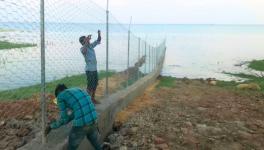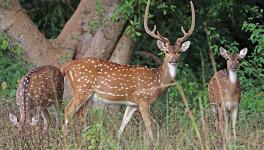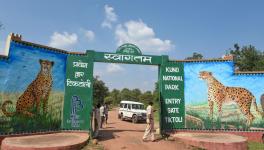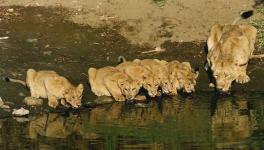Govt’s Cheetah Action Plan is Based on Poor Science: Ravi Chellam
Image Courtesy: Wikimedia Commons
Dr Ravi Chellam has been a wildlife conservationist since the 1980s. As CEO of Metastring Foundation and coordinator of the Biodiversity Collaborative, he has been involved with protecting the Asiatic lion for decades. In a previous interview with NewsClick, he had warned that introducing cheetahs from Namibia to India would be a “very costly mistake”. After the recent death of three of the cheetahs imported from Namibia and South Africa to Kuno National Park in Madhya Pradesh, he tells independent journalist Rashme Sehgal that the Action Plan for cheetahs does not just have a weak scientific foundation, but the government now seems to be deviating from that weak plan—meaning it is unclear what exactly the plan for cheetahs is.
Rashme Sehgal: We have witnessed the deaths of three cheetahs. The Namibian cheetah on March 27, from chronic kidney disease, the second, a South African cheetah, died on April 23, from an unknown disease, and now the most recent death of a South African female cheetah, after being attacked by a male during courtship. This whole translocation effort seems to be beset with major problems.
Ravi Chellam: A few deaths do not signal the failure of the project as much as a few births do not indicate its success. What is important is to fully understand the context and the reasons for these deaths. Could these have been avoided? What are the lessons that we can learn from this experience? In the case of the most recent death, Vincent van der Merwe an expert with the Cheetah Metapopulation Project, which facilitated the translocation from South Africa, who is closely involved with the project, is on record that prolonged captivity has resulted in elevated levels of stress in the cheetahs. Given this, I wonder why they tried to mate the female in captivity. It is important to remember that all three cheetahs have died in captivity even before they have been released. Due to three different reasons, though. The authorities haven’t yet confirmed the reasons for the death of the second cheetah, a male, Uday, from South Africa. Only symptoms and preliminary findings of the post mortem have been shared till now.
Another expert on wild cheetahs is the South African Dr Gus Mills who, in response to a question from an Indian journalist, said that in the wild, interactions between male and female cheetahs are infrequent, but may indeed be aggressive. When the two sexes meet the males often harass the female, probably trying to assess her reproductive condition. These interactions may sometimes last an hour or more before the male leaves her if she is not in heat, occasionally in a mortally injured state. In confined conditions, it is not a good idea to force the animals together in the hope that they might mate. Far better for this to take place in a natural situation, so that the animals have the opportunity to avoid frequent contact. I have no doubt that the captive situation increases the chances of the female getting mortally injured.
As regarding the second death of the cheetah Uday, Dr Mills said there was a possibility that the male cheetah died because of an injury received from running into a fence. There have been examples such as this and it was possible that this could recur in the future, if they were being allowed to hunt in confined, fenced areas.
RS: There is also the apprehension that Uday could have died because of the long time he spent in a boma and the stress he was undergoing, having been forced to live in captivity in Kuno Park. There is also the apprehension that it could be a case of botulism because the animal was being fed the meat of water buffaloes and goats which is not their natural food. The Indian forest department has said it is death by heart failure but that is neither here nor there. Your views?
RC: We have to wait for the complete and detailed post mortem report, result of all the lab tests and the diagnosis from the Madhya Pradesh Forest Department to gain a more comprehensive understanding of the available facts and to try and reach an informed conclusion. Vincent Van Der Merwe has gone public that it is not possible to know the cause of death until the blood test results are in the public domain. He also said that although these cheetahs are wild, they have spent over eight per cent of their lives in quarantine which cannot be healthy and that they were losing their fitness during their quarantine, on account of the long wait by the South African government. Losing fitness, getting stressed, incorrect food in Kuno and incorrect feeding regime may have also had a role to play.
RS: Obviously, Project Cheetah is facing many unexpected challenges. On April 22, we were witness to a cheetah making its way out of Kuno to reach the border of Uttar Pradesh. This one was brought back but is this always going to be viable?
RC: This along with a few other issues have been repeatedly flagged by many of us for a long time. Hence, I would not term these as unexpected at all. The challenges are largely along the lines that we had predicted. The Action Plan is based on weak scientific foundations and this is impacting implementation of the project. Worryingly, recent statements and actions seem to indicate that the Action Plan is no longer being followed and it is not clear what is guiding the current thinking and action. It is important for transparency and accountability that government provides clarity on this. The most recent statements from the government is that cheetahs will not be captured if they move outside the protected area, unless their lives are at risk.
RS: The reintroduction of large carnivores is an extremely complex and risky business, especially given that Kuno is an unfenced, unprotected area that supports a high density of competing predators including leopards, wolves and sloth bears. Another 11 cheetahs are expected to be released in two months. Can Kuno support this larger population?
RC: The Action Plan mentions that Kuno National Park can support up to 21 cheetahs and the larger landscape could support up to 36 cheetahs. These numbers have been questioned by some of us by using the best available science. More recently, those closely involved with the project, including the Madhya Pradesh Forest Department, have also started questioning the carrying capacity estimates provided in the Action Plan. This indicates that in reality the carrying capacity of Kuno is probably much lower than what is mentioned in the Action Plan.
RS: Should cheetahs be kept in fenced areas or in open, non-fenced areas?
RC: Based on the stated objectives of the Action Plan, the cheetahs have to be free ranging and not kept in fenced areas beyond the first couple of months of their arrival in India. If kept in fenced areas, irrespective of the size of the enclosure, it will still be in captivity and the anticipated ecological functions and conservation roles would be compromised. Fenced protected areas are alien and not in tune with the Indian conservation ethos, practice or frameworks, and will severely impact ecology, conservation and co-existence with local communities.
RS: The Kuno authorities have asked NTCA to find an alternative habitat for some of the cheetahs which have been brought here. Already two of the cheetahs that were brought here have been found to be exploring a large part of the buffer area. In retrospect, has the Indian government hurried this Project Cheetah without preparing for adequate size and quality habitats?
RC: There is no doubt that this project has not only been hurried through and it is also based on poor science, which has not been subjected to adequate peer review. Where was the need to import 20 cheetahs in this hurried manner when it is clear that we are not sufficiently prepared to release them for several months, resulting in their prolonged captivity? The scientific foundations of the Action Plan are weak and we have got our priorities mixed up by importing the cheetahs before ensuring the required levels of preparation, especially in terms of the adequacy of the habitat for the cheetahs to lead a free-ranging life.
While it is very difficult to accurately predict what will happen when five more cheetahs are released in Kuno in the next few weeks, current knowledge of cheetah social organisation and spatial ecology tells us that they are much more wide ranging and exist in very low densities when compared with other species of large cats. We should expect them to explore the larger landscape and not necessarily remain confined within the boundaries of Kuno National Park.
Get the latest reports & analysis with people's perspective on Protests, movements & deep analytical videos, discussions of the current affairs in your Telegram app. Subscribe to NewsClick's Telegram channel & get Real-Time updates on stories, as they get published on our website.





















